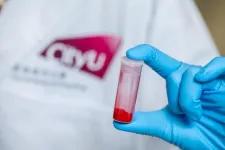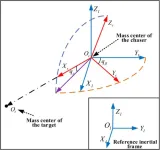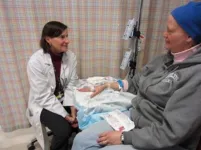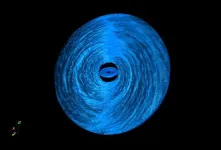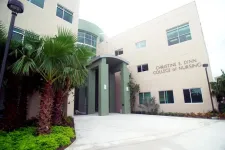(Press-News.org) A team of leading clinicians, engineers, and neuroscientists has made a groundbreaking discovery in the field of treatment-resistant depression. By analyzing the brain activity of patients undergoing deep brain stimulation (DBS), a promising therapy involving implanted electrodes that stimulate the brain, the researchers identified a unique pattern in brain activity that reflects the recovery process in patients with treatment-resistant depression. This pattern, known as a biomarker, serves as a measurable indicator of disease recovery and represents a significant advance in treatment for the most severe and untreatable forms of depression.
The team’s findings, published online in the journal Nature on September 20, offer the first window into the intricate workings and mechanistic effects of DBS on the brain during treatment for severe depression.
DBS involves implanting thin electrodes in a specific brain area to deliver small electrical pulses, similar to a pacemaker. Although DBS has been approved and used for movement disorders such as Parkinson’s disease for many years, it remains experimental for depression. This study is a crucial step toward using objective data collected directly from the brain via the DBS device to inform clinicians about the patient’s response to treatment. This information can help guide adjustments to DBS therapy, tailoring it to each patient’s unique response and optimizing their treatment outcomes.
Now, the researchers have shown it’s possible to monitor that antidepressant effect throughout the course of treatment, offering clinicians a tool somewhat analogous to a blood glucose test for diabetes or blood pressure monitoring for heart disease: a readout of the disease state at any given time. Importantly, it distinguishes between typical day-to-day mood fluctuations and the possibility of an impending relapse of the depressive episode.
The research team, which includes experts from the Georgia Institute of Technology, the Icahn School of Medicine at Mount Sinai, and Emory University School of Medicine, used artificial intelligence (AI) to detect shifts in brain activity that coincided with patients' recovery.
The study, funded by the National Institutes of Health Brain Research Through Advancing Innovative Neurotechnologies ®, or the BRAIN Initiative ®, involved 10 patients with severe treatment-resistant depression, all of whom underwent the DBS procedure at Emory University. The study team used a new DBS device that allowed brain activity to be recorded. Analysis of these brain recordings over six months led to the identification of a common biomarker that changed as each patient recovered from their depression. After six months of DBS therapy, 90 percent of the subjects exhibited a significant improvement in their depression symptoms and 70 percent no longer met the criteria for depression.
The high response rates in this study cohort enabled the researchers to develop algorithms known as "explainable artificial intelligence" that allow humans to understand the decision-making process of AI systems. This technique helped the team identify and understand the unique brain patterns that differentiated a "depressed" brain from a "recovered" brain.
"The use of explainable AI allowed us to identify complex and usable patterns of brain activity that correspond to a depression recovery despite the complex differences in a patient’s recovery,” explained Sankar Alagapan PhD, a Georgia Tech research scientist and lead author of the study. ”This approach enabled us to track the brain’s recovery in a way that was interpretable by the clinical team, making a major advance in the potential for these methods to pioneer new therapies in psychiatry.”
Helen S. Mayberg, MD, co-senior author of the study, led the first experimental trial of subcallosal cingulate cortex (SCC) DBS for treatment-resistant depression patients in 2003, demonstrating that it could have clinical benefit. In 2019, she and the Emory team reported the technique had a sustained and robust antidepressant effect with ongoing treatment over many years for previously treatment-resistant patients.
“This study adds an important new layer to our previous work, providing measurable changes underlying the predictable and sustained antidepressant response seen when patients with treatment-resistant depression are precisely implanted in the SCC region and receive chronic DBS therapy,” said Dr. Mayberg, now Founding Director of the Nash Family Center for Advanced Circuit Therapeutics at Icahn Mount Sinai. “Beyond giving us a neural signal that the treatment has been effective, it appears that this signal can also provide an early warning signal that the patient may require a DBS adjustment in advance of clinical symptoms. This is a game changer for how we might adjust DBS in the future.“
"Understanding and treating disorders of the brain are some of our most pressing grand challenges, but the complexity of the problem means it's beyond the scope of any one discipline to solve,” said Christopher Rozell, PhD, Julian T. Hightower Chair and Professor of Electrical and Computer Engineering at Georgia Tech and co-senior author of the paper. “This research demonstrates the immense power of interdisciplinary collaboration. By bringing together expertise in engineering, neuroscience, and clinical care, we achieved a significant advance toward translating this much-needed therapy into practice, as well as an increased fundamental understanding that can help guide the development of future therapies."
The team's research also confirmed a longstanding subjective observation by psychiatrists: as patients' brains change and their depression eases, their facial expressions also change. The team's AI tools identified patterns in individual facial expressions that corresponded with the transition from a state of illness to stable recovery. These patterns proved more reliable than current clinical rating scales.
In addition, the team used two types of magnetic resonance imaging to identify both structural and functional abnormalities in the brain’s white matter and interconnected regions that form the network targeted by the treatment. They found these irregularities correlate with the time required for patients to recover, with more pronounced deficits in the targeted brain network correlated to a longer time for the treatment to show maximum effectiveness. These observed facial changes and structural deficits provide behavioral and anatomical evidence supporting the relevance of the electrical activity signature or biomarker.
"When we treat patients with depression, we rely on their reports, a clinical interview, and psychiatric rating scales to monitor symptoms. Direct biological signals from our patients' brains will provide a new level of precision and evidence to guide our treatment decisions,” said Patricio Riva-Posse, MD, Associate Professor and Director of the Interventional Psychiatry Service in the Department of Psychiatry and Behavioral Sciences at Emory University School of Medicine, and lead psychiatrist for the study.
Given these initial promising results, the team is now confirming their findings in another completed cohort of patients at Mount Sinai. They are using the next generation of the dual stimulation/sensing DBS system with the aim of translating these findings into the use of a commercially available version of this technology.
Research reported in this press release was supported by the National Institutes of Health BRAIN Initiative under award number UH3NS103550; the National Science Foundation, grant No. CCF-1350954; the Hope for Depression Research Foundation; and the Julian T. Hightower Chair at Georgia Tech. Any opinions, findings, and conclusions or recommendations expressed in this material are those of the authors and do not necessarily reflect the views of any funding agency.
https://www.mountsinai.org/profiles/helen-s-mayberg
https://www.mountsinai.org/about/newsroom/2019/long-term-follow-up-data-shows-deep-brain-stimulation-is-an-effective-treatment-for-treatment-resistant-depression
https://icahn.mssm.edu/research/advanced-circuit-therapeutics
https://ece.gatech.edu/directory/christopher-john-rozell
https://med.emory.edu/directory/profile/?u=PRIVAPO
https://siplab.gatech.edu/rozell.html
https://www.emoryhealthcare.org/centers-programs/treatment-resistant-depression-program/index.html
About the Mount Sinai Health System
Mount Sinai Health System is one of the largest academic medical systems in the New York metro area, with more than 43,000 employees working across eight hospitals, over 400 outpatient practices, nearly 300 labs, a school of nursing, and a leading school of medicine and graduate education. Mount Sinai advanced health for all people, everywhere, by taking on the most complex health care challenges of our time — discovering and applying new scientific learning and knowledge; developing safer, more effective treatments; educating the next generation of medical leaders and innovators; and supporting local communities by delivering high-quality care to all who need it.
Through the integration of its hospitals, labs, and schools, Mount Sinai offers comprehensive health care solutions from birth through geriatrics, leveraging innovative approaches such as artificial intelligence and informatics while keeping patients’ medical and emotional needs at the center of all treatment. The Health System includes approximately 7,300 primary and specialty care physicians; 13 joint-venture outpatient surgery centers throughout the five boroughs of New York City, Westchester, Long Island, and Florida; and more than 30 affiliated community health centers. We are consistently ranked by U.S. News & World Report's Best Hospitals, receiving high "Honor Roll" status, and are highly ranked: No. 1 in Geriatrics and top 20 in Cardiology/Heart Surgery, Diabetes/Endocrinology, Gastroenterology/GI Surgery, Neurology/Neurosurgery, Orthopedics, Pulmonology/Lung Surgery, Rehabilitation, and Urology. New York Eye and Ear Infirmary of Mount Sinai is ranked No. 12 in Ophthalmology. U.S. News & World Report’s “Best Children’s Hospitals” ranks Mount Sinai Kravis Children's Hospital among the country’s best in several pediatric specialties. For more information, visit https://www.mountsinai.org or find Mount Sinai on Facebook, Twitter and YouTube.
END
Decoding depression: Researchers identify crucial biomarker that tracks recovery from treatment-resistant depression
Harnessing the power of explainable AI, researchers have unveiled the first insights into the complex workings of deep-brain stimulation therapy for treatment-resistant depression
2023-09-20
ELSE PRESS RELEASES FROM THIS DATE:
CityU researchers develop novel photo-oxidation therapy for anticancer treatment
2023-09-20
A research team led by scientists from City University of Hong Kong (CityU) has achieved a significant breakthrough by inventing a new class of near-infrared-activated photo-oxidants that can effectively kill cancer cells without requiring oxygen. The photo-oxidants induce a unique form of cancer cell death that can overcome cancer cell resistance. The findings offer a new strategy, called ‘photo-oxidation therapy’, and provide a promising direction for the development of anti-cancer drugs.
Photodynamic therapy, an innovative ...
Multimillion-dollar scientific grant program releases third cycle of funding to increase foundational understanding of sarcoidosis
2023-09-20
WASHINGTON (September 20, 2023)—The Ann Theodore Foundation Breakthrough Sarcoidosis Initiative (ATF-BSI), in partnership with the Milken Institute, launched its latest round of funding today. Up to $3.4 million in total funding will be made available to researchers from around the world whose work aims to increase scientific understanding of sarcoidosis. The program is accepting applications for two-year research projects and intends to award four to six research grants from doctorate-level investigators at qualifying research-based institutions worldwide. Awardees may be eligible for a third year of funding.
Sarcoidosis is an inflammatory ...
Zhijian ‘James’ Chen and Glen Barber awarded Horwitz prize for discovering the cGAS-STING pathway
2023-09-20
NEW YORK, NY (September 20, 2023)—Columbia will award the 2023 Louisa Gross Horwitz Prize to Zhijian ‘James’ Chen and Glen Barber for discovering the cGAS-STING pathway, a key component of one of the body’s first line of defenses, the innate immune system.
When pathogens infiltrate our cells, they leave behind traces of their DNA. These molecular fingerprints are detected by our cGAS-STING pathway, which sounds the alarm and mobilizes the immune system to eliminate invading threats. Research on the cGAS-STING pathway has revealed the ...
Scientists researched on finite-time anti-saturated proximity control with a tumbling non-cooperative space target
2023-09-20
The past few decades have witnessed the burgeoning development of on-orbit servicing in light of various meaningful space applications such as repair of malfunctioning satellites, debris removal, on-orbit assembly, and so on. As for the orbit-servicing targets, they are usually divided into 2 categories, i.e., cooperative and non-cooperative ones, based on whether the space targets have active cross-link communication and cooperative identifiers with the servicing spacecraft or not. Before executing the orbit-servicing task, close-range rendezvous and proximity is an inevitable process in which ...
Australian biobank aims to discover new treatments for children with genetic muscle diseases
2023-09-20
An Australian-first biobank will be established to improve and discover new treatments for children with genetic muscle diseases.
The National Muscle Disease Bio-databank, co-led by Murdoch Children’s Research Institute, Monash University and Alfred Health, will advance research into understanding why children develop genetic muscle diseases. The project forms part of a $2.5 million Medical Research Future Fund grant awarded to the team for research into congenital muscle diseases.
These diseases, spanning dystrophies and myopathies, are characterised by severe muscle weakness, usually from infancy, that can impact swallowing, ...
A study published in Chinese Medical Journal reveals potential of methotrexate to treat liver cancer
2023-09-20
Liver cancer is one of the most prevalent and deadly types of cancer worldwide. Most patients are diagnosed at an advanced stage, which leaves them with few treatment options. Unfortunately, the first-line drugs used in advanced hepatocellular carcinoma (HCC), the most common type of liver cancer, are not very effective and offer only modest clinical benefits.
Over the past few years, scientists have been trying to develop new therapies for HCC by analyzing specific genetic abnormalities and the ways in which they affect the manifestation and progression of the disease. One of the most common mutations in HCC ...
State Council in Virginia approves new UVA Data Science Major
2023-09-20
The State Council of Higher Education for Virginia (SCHEV) approved Tuesday the creation of an undergraduate major for the University of Virginia’s School of Data Science, a landmark development for the four-year-old school, which was the first of its kind in the nation.
Prior to Tuesday’s announcement, undergraduates could obtain a minor in data science, while graduate students could pursue master’s or doctoral degrees. Now, the establishment of the B.S. in Data Science will allow UVA’s undergraduates to focus their studies on this emerging and growing interdisciplinary field.
“The B.S. in Data Science major is a major milestone ...
A newly identified virus emerges from the deep
2023-09-20
Highlights:
Organisms, including viruses, live in the deepest, darkest places on the planet
Marine virologists analyzed sediment from the Mariana Trench, the deepest place on Earth, and identified a new bacteriophage
The phage infects Halomonas bacteria, which have been found in deep-sea environments and near hydrothermal vents
The study helps probe how phages and hosts evolve together in secluded, hostile environments
Washington, D.C. — The Mariana Trench, the deepest place on Earth, plunges nearly 11,000 meters at its lowest point on the floor ...
Black holes eat faster than previously expected
2023-09-20
A new Northwestern University-led study is changing the way astrophysicists understand the eating habits of supermassive black holes.
While previous researchers have hypothesized that black holes eat slowly, new simulations indicate that black holes scarf food much faster than conventional understanding suggests.
The study will be published on Wednesday (Sept. 20) in The Astrophysical Journal.
According to new high-resolution 3D simulations, spinning black holes twist up the surrounding space-time, ultimately ripping apart ...
FAU receives $1.3 million grant for Alzheimer’s outreach in Broward County
2023-09-20
Florida Atlantic University’s María de los Ángeles Ortega, DNP, APRN, in the Christine E. Lynn College of Nursing, has been awarded a three-year, $1.3 million grant from the Administration for Community Living’s (ACL) Alzheimer’s Disease Program Initiative for a groundbreaking project designed to advance health equity and improve quality of life for individuals living with or at high risk for Alzheimer’s disease and related dementias (ADRD) and their family caregivers.
ACL was created around the fundamental principle that all people, regardless of age or disability, should be able to live independently ...
LAST 30 PRESS RELEASES:
Heart-brain connection: international study reveals the role of the vagus nerve in keeping the heart young
Researchers identify Rb1 as a predictive biomarker for a new therapeutic strategy in some breast cancers
Survey reveals ethical gaps slowing AI adoption in pediatric surgery
Stimulant ADHD medications work differently than thought
AI overestimates how smart people are, according to HSE economists
HSE researchers create genome-wide map of quadruplexes
Scientists boost cell "powerhouses" to burn more calories
Automatic label checking: The missing step in making reliable medical AI
Low daily alcohol intake linked to 50% heightened mouth cancer risk in India
American Meteorological Society announces Rick Spinrad as 2026 President-Elect
Biomass-based carbon capture spotlighted in newly released global climate webinar recording
Illuminating invisible nano pollutants: advanced bioimaging tracks the full journey of emerging nanoscale contaminants in living systems
How does age affect recovery from spinal cord injury?
Novel AI tool offers prognosis for patients with head and neck cancer
Fathers’ microplastic exposure tied to their children’s metabolic problems
Research validates laboratory model for studying high-grade serous ovarian cancer
SIR 2026 delivers transformative breakthroughs in minimally invasive medicine to improve patient care
Stem Cell Reports most downloaded papers of 2025 highlight the breadth and impact of stem cell research
Oxford-led study estimates NHS spends around 3% of its primary and secondary care budget on the health impacts of heat and cold in England
A researcher’s long quest leads to a smart composite breakthrough
Urban wild bees act as “microbial sensors” of city health.
New study finds where you live affects recovery after a hip fracture
Forecasting the impact of fully automated vehicle adoption on US road traffic injuries
Alcohol-related hospitalizations from 2016 to 2022
Semaglutide and hospitalizations in patients with obesity and established cardiovascular disease
Researchers ‘listen in’ to embryo-mother interactions during implantation using a culture system replicating the womb lining
How changing your diet could help save the world
How to make AI truly scalable and reliable for real-time traffic assignment?
Beyond fragmented markets: A new framework for efficient and stable ride-pooling
Can shape priors make road perception more reliable for autonomous driving?
[Press-News.org] Decoding depression: Researchers identify crucial biomarker that tracks recovery from treatment-resistant depressionHarnessing the power of explainable AI, researchers have unveiled the first insights into the complex workings of deep-brain stimulation therapy for treatment-resistant depression
